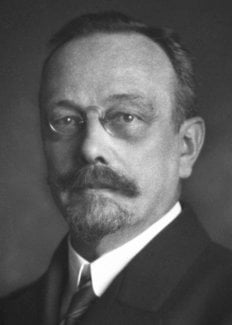Johannes Fibiger
Biographical

Johannes Andreas Grib Fibiger was born at Silkeborg (Denmark) on April 23, 1867. His father, C. E. A. Fibiger, was a local medical practitioner and his mother, Elfride Muller, was a writer. Fibiger gained his bachelor’s degree in 1883 and qualified as a doctor in 1890. After a period of working in hospitals and studying under Koch and Behring he was, from 1891 to 1894, assistant to Professor C. J. Salomonsen at the Department of Bacteriology of Copenhagen University. While serving as an Army reserve doctor at the Hospital for Infectious Diseases (Blegdam Hospital) in Copenhagen from 1894 to 1897 he completed his doctorate thesis on «Research into the bacteriology of diphtheria». He received his doctorate of the University of Copenhagen in 1895, and was subsequently appointed prosector at the University’s Institute of Pathological Anatomy (1897-1900), Principal of the Laboratory of Clinical Bacteriology of the Army (1890-1905), and (in 1905) Director of the Central Laboratory of the Army and Consultant Physician to the Army Medical Service. After studying for some time under Orth and Weichselbaum, Fibiger was appointed Professor of Pathological Anatomy at Copenhagen University and Director of the Institute of Pathological Anatomy (1900).
Fibiger fulfilled a large number of official missions and took part in the direction of numerous institutions. He was First Secretary, and later President of the Danish Medical Society, Consultant to the Council of Forensic Medicine, member of the Planning Commission for the Construction of the Medical Institutes of the National Hospital; Vice-President, and later President of the Danish Medical Association’s Cancer Commission, member of the National Radium Committee, member of the Administrative Council of the Rask-Ørsted Foundation, of the Northern Society to Promote a Biological Station in the Tropics, of the Pasteur Society; he was a founder-member and joint-editor of the Acta Pathologica et Microbiologica Scandinavica, co-editor of Ziegler’s Beiträge zur pathologischen Anatomie und zur allgemeinen Pathologie, member of the International Commission for Intellectual Cooperation with Other Countries, representing his country at numerous congresses and meetings, and member of a great many academies and societies, both Danish and foreign. Fibiger was also Vice-President, and afterwards President, of «Die internationale Vereinigung für Krebsforschung», member of the Royal Academy of Science and Literature of Denmark, of the Swedish Medical Association, of the Finnish Medical Association, corresponding member of the «Association française pour l’Étude du Cancer», of the «Société de Biologie» of Paris, of the Helmintological Society of Washington, founder-member of «Van Leeuwenhoekvereeniging» for cancer study by experiment, honorary member of the Royal Academy of Medicine of Belgium and of the «Wiener dermatologischen Gesellschaft», member of the Royal Society of Physiography of Lund and of the Royal Society of Science of Uppsala, honorary doctor of the Universities of Paris and Louvain, etc. Fibiger was the winner of numerous prizes, among which should be mentioned the Nordhoff-Jung Cancer Prize and the Nobel Prize for Physiology or Medicine, 1927, for his work on cancer.
Fibiger died on January 30, 1928, at Copenhagen after a short illness (cardiac failure with multiple emboli and massive pulmonary infarcts; cancer of the colon: caecostomy), survived by his wife Mathilde, née Fibiger, whom he married in 1894.
This autobiography/biography was written at the time of the award and first published in the book series Les Prix Nobel. It was later edited and republished in Nobel Lectures. To cite this document, always state the source as shown above.
The Nobel Foundation's copyright has expired.Nobel Prizes and laureates
Six prizes were awarded for achievements that have conferred the greatest benefit to humankind. The 12 laureates' work and discoveries range from proteins' structures and machine learning to fighting for a world free of nuclear weapons.
See them all presented here.
